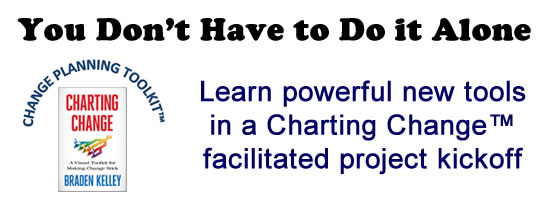Snuff out SWOT – Forever

The more strategy development work I do with organizations, the more I’m becoming aware of a prevalent pattern, a pattern which I find counterproductive, even detrimental. It concerns the starting point for their strategy work: in nearly every case, they begin with convergent thinking, the polar opposite of divergent thinking, which I believe is the kind of thinking true strategy demands.
To show just how embedded this pattern is in the corporate mind, take a moment to mentally fill in the blanks:
Strategic ______________
SWOT _________________
Invariably, the answers I get when I do this short exercise in workshops are “planning” and “analysis.”
Here’s the rub: planning and analysis are convergent modes of thinking. But if strategy is about considering many possibilities and making critical choices, this kind of thinking doesn’t work. Perhaps that’s why so many people struggle with strategy.
In fact, it’s probably the very reason the starting point for most is the SWOT (Strengths, Weakness, Opportunity, Threat) Analysis. SWOT is the most dominant way to begin strategy efforts. Sounds cool, right? “We’ve done a SWOT.” Woo hoo! It’s a great acronym…sounds like SWAT (special weapons and tactics). So it’s a brilliant marketing gimmick. No one actually knows who came up with SWOT, which is a bit curious…maybe whoever did wanted to remain anonymous for a reason.
Be that as it may, let’s think about SWOT for a moment. Generally, some poor young MBA gets sent out to do a SWOT analysis, which will then be turned into a “strategic plan,” complete with who, what, when, how, and how much ($).
But let’s back up and parse the SWOT, starting with the “S,” for strength. What is a strength? When we say “strength,” we are loading the concept with a silent context. Context is what gives the word meaning in the first place. There is no such thing as a universal strength in business life. I cannot think of a single strength that is a strength in all contexts. A strength in one context can be a weakness in another context.
In fact, this is the very point Malcolm Gladwell was trying desperately to make in his 2013 book, David and Goliath. (Sidenote: Now, he failed to make his point in the telling of his story, because he got caught up in trying to convince us that people succeed because of their weaknesses, rather than because they overcome them, but that’s irrelevant to the argument at hand.)
This one line was my main takeaway from the book: “The powerful and the strong are not always what they seem.” Gladwell was talking about the power of context, which ironically he introduced us to in his first and best book, The Tipping Point. David beat Goliath because he changed the context within which the battle was fought, not because he was weaker than Goliath.
A strength is only a strength in the context of the strategic choices at the heart of strategy: where you’ve chosen to play and how you’ve chosen to win in that specific space. For that matter, a weakness is only a weakness in the context of a where-to-play/how-to-win choice. The same holds for opportunities and threats.
My point: if you start your strategy efforts with a SWOT, without having an explicit, and explicitly different, strategic choice, the poor schmo who’s actually doing that SWOT has to decide what to pay attention to and what to ignore. The reason being, it’s impossible to do a SWOT analysis of everything. That’s a century-long assignment of a million or so pages in length, and our young MBA only has six weeks and 250 pages to do his SWOT.
And the easiest thing for the SWOTer to do? Assume the current strategy. “Given our current plan, our SWOT looks like this.”
Which is why most “new” strategies end up looking a lot like the “old” strategy.
I used to be agnostic on SWOT. No longer. I’m violently against it as the starting point for strategy.
I now think it’s far better to think through various strategic choices, ask what would have to be true for those choices to be good ones, and explore those hypotheses through valid experiments, before ever locking and loading on a strategy. It’s creative and divergent thinking, which is the polar opposite of the convergent thinking that fuels planning and analysis.
The difference between divergent and convergent thinking is the difference between chess and checkers. Both games are played on the same board, both games have the same number of players. With checkers, though, you really don’t have much to think about, the players are all the same, and the moves are single, linear steps. Chess has far more kinds of players, far more possibilities and options to consider, including the competitive response to a single move. That’s why when you watch the chess masters play (not sure why you’d want to do that), the “action” is mostly invisible…they’re thinking about their choices and and the possible reactions to those choices.
If you want and need a new strategy, swat your SWOT. Forever.
Wait! Before you go…
Choose how you want the latest innovation content delivered to you:
- Daily — RSS Feed — Email — Twitter — Facebook — Linkedin Today
- Weekly — Email Newsletter — Free Magazine — Linkedin Group
 Matthew E. May is the author, most recently, of Winning the Brain Game: Fixing the 7 Fatal Flaws of Thinking.
Matthew E. May is the author, most recently, of Winning the Brain Game: Fixing the 7 Fatal Flaws of Thinking.
NEVER MISS ANOTHER NEWSLETTER!
LATEST BLOGS
The Incredible Shrinking Laptop
As technology advances and people’s demands for ever-thinner, ever-lighter laptops increase, more and more the thickness of a laptop is…
Read MoreA Revolution in Management Consulting?
Management consulting firms are built on a model that requires the maintenance of a bench of their people to staff…
Read More



